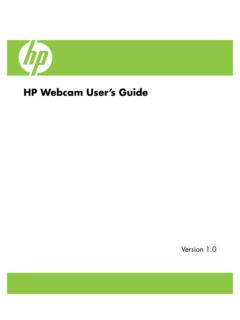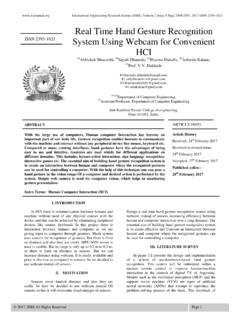Transcription of Autoguiding System Essentials - Shoestring Astronomy
1 Autoguiding System Essentials Doug Anderson Shoestring Astronomy Amateur astrophotography is more popular today than it has ever been. This is due primarily to the widespread availability of equipment that produces amazing, high-quality results with relative ease at prices that are affordable to many. In order to produce images of deep sky objects, especially at focal lengths over 200mm, it usually becomes necessary to guide the telescope during the image exposure. Even the finest, most expensive mounts are plagued with enough mechanical imperfection or alignment error to produce oblong stars. Historically, guiding was done with the photographer staring through an eyepiece at a guide star and manually correcting the movement of the scope to keep the guide star s position fixed. This is the most grueling, error-prone aspect of the art. Within the last decade, companies such as Santa Barbara Instrument Group (SBIG) have developed and sold dedicated Autoguiding systems that have unchained the photographer from his eyepiece and increased the success rate achieved.
2 These systems are very effective, but also relatively expensive. Within the past few years, amateur astronomers have discovered that inexpensive, widely available imaging cameras can work quite well as lunar and planetary imagers using the proper techniques. Commensurate with this discovery was also the realization that these imagers can be used as part of a much less expensive, but equally effective autoguide System . Compared to a dedicated autoguider, autoguide systems take a little more understanding on the part of the amateur to build and set up initially. However, once the work is done on the front end, the results are definitely worth the effort expended as well as the money saved. This article will attempt to make this effort a little simpler by providing an overview of the entire System . The Autoguide System Any autoguide System is composed of the same basic elements: 1) Telescope Mount 2) Guide Scope 3) Guide Imager 4) Computer 5) Mount Link 6) Autoguide Software Guide ScopeGuide ImagerComputerTelescope MountMount LinkAutoguideSoftwareEven a stand-alone dedicated autoguide System is composed of these elements with many of the pieces combined so that they are not so apparent to the user.
3 Each of these elements will be covered in greater detail. Telescope Mount The telescope mount is the foundation of an astronomical imaging System . Just as building a house on a weak foundation will lead to problems later, trying to image using a mount that is not up to the task can lead to a great deal of frustration. An autoguide System can compensate for some imperfections in the mount, but it is limited in its ability. The fewer problems you have with your mount that must be solved, the better your likelihood that the System will perform adequately. In order to take exposures lasting more than a few seconds, the mount must be an equatorial style mount. Furthermore, accurate polar alignment of the mount is necessary in order to avoid field rotation during imaging. When an autoguide System is working it can track one star accurately, but it cannot correct for the rotation of the rest of the field about the guide star.
4 This can only be eliminated with proper polar alignment or with a field derotator. Guide Scope An autoguided astrophotography System will have two imagers, and thus will need two light paths for starlight to get to the imagers. The primary imager, the one actually taking the astrophotograph, will receive its light through the primary scope. The guide imager will receive its light through the guide scope. These two scopes must be linked together mechanically as tightly as possible. If one telescope moves relative to the other one, termed differential flexure, then less than perfect images will be produced. This flexure may be caused by loose or non-rigid connections between the scopes, or even from mirror flop which is a common problem with many Schmidt-Cassegrain style telescopes. One way to avoid the problem of differential flexure, and also to avoid the need to own two telescopes and a method to link them together, is to use a device called an off-axis guider.
5 This device allows light to pass through to the primary imager, but includes a small prism that is outside the imager field-of-view that redirects light to the guide imager. Some photographers prefer this method, but many find that it is difficult to use because it requires a guide star of sufficient brightness to be very near the primary imaging target. Guide Imager Autoguiding requires the use of an electronic eye to replace the human eye that is used in manual guiding. It is the guide imager that takes a series of exposures and passes them on to the computer where they are analyzed and decisions on how to correct the mount s movement are made. With the advent of webcams and inexpensive lunar, planetary, and DSO imagers into Astronomy , the guide imager is now a readily available item. Webcams that are popular amongst astrophotographers include the Philips Toucam and Logictech Quickcam.
6 Lunar/planetary imagers include the Orion StarShoot Solar System Imager, Celestron NexImage and Meade LPI. DSO imagers include Orion s StarShoot Deep Space Imager, Meade s Deep Sky Imager, Fishcamp s Starfish, and CCD-lab s Q-guide. All of these imagers use a USB interface to transfer the image to a host computer. Webcams that are suitable for use as guide imagers will need a lens that is removable. After the lens is removed, it is replaced with an adapter that allows the webcam to be inserted in the focuser tube of the guide scope. These adapters can be purchased through various sources on the Internet, or even home-made. Some of these imagers, primarily the webcams, have a limited exposure time that sets the lower limit on how dim a guide star can be used. With an unmodified Toucam, one can easily guide on a magnitude 7 star using an 80mm refractor as a guide scope or on a magnitude 9 star with a 203mm Schmidt-Cassegrain guide scope.
7 By pushing things a bit, stars that are one magnitude dimmer can be used. If you would like to guide on dimmer stars than a stock webcam provides, amateur astronomers such as Steve Chambers ( ) have developed techniques to modify the webcams to make them capable of taking longer exposures. These techniques usually introduce additional electrical signals that must be properly stimulated by the host computer. The control of these added signals has traditionally been done using a PC s parallel port or serial port. At the other end of the exposure time scale, guide imager exposures cannot be allowed to go too long. For one thing, the amount of electronic noise in the imager increases as the exposure time grows. Eventually, the guide star will be lost in a sea of noise. The other problem is that the autoguide System needs updates on the position of the guide star before the mount has had a chance to wander too far off from its ideal path.
8 Computer While the guide imager is the eye of the autoguide System , a personal computer is the brains of the System . The computer will use the guide imager to take images of the guide star and compare the current location of the guide star in the image to the reference position it was at when the autoguide session was started. The location of the center of the guide star is usually mathematically computed to sub-pixel accuracy using a method called common-centroid. After the difference between the current location of the guide star and its reference location is computed, the computer will then make a decision on what, if any, correction should be made to the direction the scope mount is pointed. If a correction is to be made, then the computer sends a command to the scope mount to make this correction. While this is a fair amount of work for the computer to do, it is really not a huge task for most personal computers.
9 Thus, it is not necessary to have the latest, greatest laptop running the most recent operating System and stuffed full of memory and hard-drive space. An older model can be quite adequate for the task. However, what is necessary is that the computer has enough of the proper interface ports (serial, parallel, USB) to allow connection to all the various parts of the autoguide System and any equipment you might want it to operate concurrently while Autoguiding . One of the nice features of the USB interface is that additional ports can be easily added with an inexpensive USB hub. If you need additional serial ports, there are USB-to-serial adapters available. Parallel port adapters are not as common, but there are adapters that provide parallel ports through a PCMCIA (PC slot). One should seek to minimize the number of other applications that are running during an autoguide session.
10 Even though a computer appears to have the ability to do many tasks at once, it is really only capable of doing one thing at a time. Autoguiding is a fairly critical real-time task, and it is best to let it run with as little interruption as possible. If the autoguide software decides it is time to adjust the tracking of the mount, but the computer is busy with another task, the move cannot be initiated until after the current task is complete. This can lead to less than optimal guiding. Mount Link As mentioned above, once the computer decides that the path of the telescope mount must be corrected, it will send a correction command to the mount. In order to do this, it must have a way to communicate with the mount. There are several ways that this can be done. Guide Port- Many telescope mounts have a dedicated autoguide port built in, on some mounts this is referred to as a CCD port.










